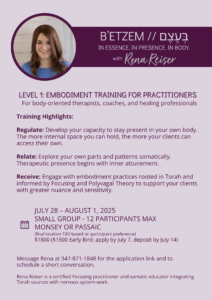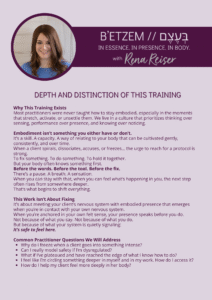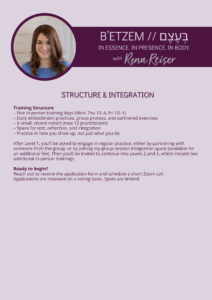What’s blocking her during intimacy?
If your client is bringing up the topic of intimacy in the therapy room, and many women are, then we as practitioners need to be able to meet her there and know how to help her move forward in an embodied way. Gently, clearly, and from a grounded place in ourselves.
We need clarity on what’s really happening in the body. What intimacy requires. And what shifts when we’re able to meet what’s there, instead of avoiding it, whether in ourselves or in our clients.
I’ve heard a lot of women say that intimacy is fine, but they don’t particularly like it or look forward to it. This client might need some advice. She might need some psychoeducation. But more than that, she needs to be able to be present in her body. Gently.
If we avoid working with the body, we risk that the client now has more information but doesn’t know how to actualize it. She tries to apply what she’s been told, but her body’s not on board because it hasn’t been felt, experienced, or worked through using the language the body understands.
And then the client doesn’t move forward. She might even feel more ashamed and despondent. Without the capacity to be in her body to process what comes up, to stay with the sensations instead of going numb, intimacy will be a struggle for her.
And often, the way we do one thing is the way we do everything. So if a woman tends to go into specific dysregulated states in other parts of her life, there’s a strong likelihood that she tends to go into similar states during intimacy. When she is able to be more present, a transformation occurs which allows her to connect and receive what Hashem wants her to experience in life and also in intimacy.
A practitioner who understands the role of the nervous system can track when her client goes into dysregulated states or when her client has gone outside her window of tolerance. She’ll be able to guide her client to meet what comes up, when to help her ground, and when it’s safe to stay and go deeper.
Now, I’d like to invite you to pause reading this for a moment and check in with yourself. What’s your level of comfort or discomfort, not just from your mind, but in your body, around this topic?
Is your body on board with discussing this? With facing it? With having your client bring it up in session?
If you’re feeling activated around it, and aren’t aware of it or able to embrace your own dysregulation, your client’s nervous system will pick up on that. It’s all happening at a below-conscious level. And your client won’t be able to move forward if her practitioner is dysregulated, activated around the topic, and not able to hold space for that in her own self.
That’s where this upcoming facilitator training comes in.
Focusing allows us to bypass what we already know in our cognitive understanding of a situation and uncover the next steps that our body, mind, and soul need in order to move forward. The answers lie within the blocks themselves. Not in the thinking mind, not in what we already know. And not in our emotions, either.
Focusing gives us access to what’s beneath.
If this speaks to you and you’re ready to deepen your ability to hold space for your clients’ most tender places, I invite you to apply for my upcoming training.



